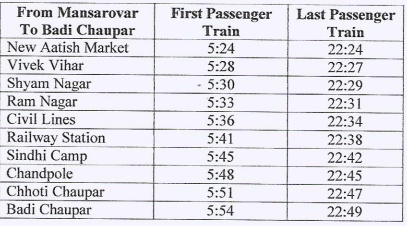Jaipur Metro, a significant development in the realm of urban transportation, has transformed the way residents and visitors navigate the Pink City. Inaugurated in 2015, the metro system has steadily expanded, providing a fast, efficient, and eco-friendly mode of transport. This article delves into the details of Jaipur Metro, including its stations, timings, fares, distances, and the latest updates for 2024.
Overview of Jaipur Metro: Jaipur Metro is operated by Jaipur Metro Rail Corporation (JMRC) and currently comprises two phases:
- Phase 1: Known as the Pink Line, this phase connects Mansarovar to Chandpole, covering a distance of 9.63 kilometers with 9 stations.
- Phase 2: The Orange Line (also known as East-West Corridor) is under construction and will extend from Sitapura to Ambabari, covering approximately 23.8 kilometers with 20 stations.
Stations:
Pink Line (Phase 1):
- Mansarovar
- New Aatish Market
- Vivek Vihar
- Shyam Nagar
- Ram Nagar
- Civil Lines
- Railway Station
- Sindhi Camp
- Chandpole
Orange Line (Phase 2) – Proposed Stations:
- Sitapura
- Pratap Nagar
- Sanganer
- Durgapura
- Gopalpura
- Tonk Phatak
- Lakshmi Mandir
- Narayan Singh Circle
- SMS Hospital
- Ajmeri Gate
- Choti Chaupar
- Badi Chaupar
- Ramganj Chaupar
- Transport Nagar
- Vivek Vihar
- Subhash Nagar
- Panipech
- Ambabari
- Vidhyadhar Nagar
- Chomu Pulia
Timings: Jaipur Metro operates daily with services running from 6:00 AM to 10:00 PM. Trains run at a frequency of 10 to 15 minutes during peak hours and 15 to 20 minutes during non-peak hours.
Fares: The fare structure of Jaipur Metro is designed to be affordable and is based on the distance traveled. As of 2024, the fare ranges from ₹10 to ₹25 for the Pink Line:
- 0-2 km: ₹10
- 2-5 km: ₹15
- 5-8 km: ₹20
- Above 8 km: ₹25
Discounted fares are available for students, senior citizens, and differently-abled passengers. Monthly passes and tokens can be purchased at metro stations.
Jaipur Metro Overview:
1. Pink Line (Phase 1):
- Source: Mansarovar
- Destination: Chandpole
- Distance: 9.63 kilometers
- Operational Since: June 3, 2015
2. Orange Line (Phase 2) – Under Construction:
- Source: Sitapura
- Destination: Ambabari
- Distance: Approximately 23.8 kilometers
- Expected Completion: 2025
Jaipur Metro route Map:

source: Rajasthan transport portal website
Pink Line (Mansarovar to Chandpole)
Stations:
- Mansarovar: The starting point of the Pink Line, a major residential and commercial area.
- New Aatish Market: Serving a significant commercial hub with a bustling market.
- Vivek Vihar: Primarily a residential area, providing metro access to local residents.
- Shyam Nagar: Another residential area with convenient access to the metro.
- Ram Nagar: Known for its residential colonies and local markets.
- Civil Lines: A prestigious area housing many government officials and high-profile residences.
- Railway Station: Provides connectivity to the Jaipur Railway Station, a key transit point.
- Sindhi Camp: One of the busiest stations due to its proximity to the inter-state bus terminal.
- Chandpole: The terminal station, located near the historic Chandpole Gate and close to the old city.
Timings:
- Weekdays (Monday to Saturday):
- First Train: 6:00 AM from Mansarovar and Chandpole
- Last Train: 10:00 PM from Mansarovar and Chandpole
- Frequency: Every 10 minutes during peak hours and every 15 minutes during non-peak hours
- Sundays and Public Holidays:
- First Train: 7:00 AM from Mansarovar and Chandpole
- Last Train: 10:00 PM from Mansarovar and Chandpole
- Frequency: Every 15 minutes throughout the day

source: Rajasthan transport portal website

source: Rajasthan transport portal website
Orange Line (Sitapura to Ambabari) – Under Construction
Proposed Stations:
- Sitapura: An industrial area with numerous manufacturing units and educational institutions.
- Pratap Nagar: A residential area with growing commercial importance.
- Sanganer: Famous for its handmade paper and textile industry.
- Durgapura: A key residential area with proximity to the airport.
- Gopalpura: A bustling area with a mix of residential and commercial establishments.
- Tonk Phatak: A major intersection known for its traffic and commercial activity.
- Lakshmi Mandir: Another important commercial area.
- Narayan Singh Circle: A significant junction connecting various parts of the city.
- SMS Hospital: The city’s largest hospital, providing critical connectivity for healthcare access.
- Ajmeri Gate: A historic gate and a busy area in the old city.
- Choti Chaupar: Close to key markets and tourist spots.
- Badi Chaupar: Near to Hawa Mahal and other major tourist attractions.
- Ramganj Chaupar: A densely populated area with vibrant local markets.
- Transport Nagar: A key area for transport and logistics services.
- Vivek Vihar: Connecting to residential areas.
- Subhash Nagar: Another residential and commercial mix area.
- Panipech: Known for its local markets and residential colonies.
- Ambabari: The terminal station of the Orange Line, providing connectivity to the northern parts of the city.
- Vidhyadhar Nagar: A residential area with several educational institutions.
- Chomu Pulia: A major connecting point on the northern outskirts of Jaipur.
Expected Timings and Frequency for Orange Line:
Once operational, the Orange Line is expected to follow a similar schedule as the Pink Line, with frequent trains during peak hours and slightly less frequent services during off-peak times. Specific timings will be announced closer to the launch date.
Latest Updates for 2024:
1. Expansion Plans: The Orange Line is progressing well with significant portions expected to be operational by 2025. The construction involves advanced tunneling techniques to minimize disruption in densely populated areas.
2. Integration with Other Modes of Transport: Efforts are underway to integrate Jaipur Metro with other public transport systems, including buses and proposed suburban rail networks. This seamless connectivity will enhance the efficiency and convenience of commuting in Jaipur.
3. Technology Upgrades: Jaipur Metro is incorporating advanced technologies such as automated fare collection systems, real-time passenger information systems, and improved security measures. These upgrades aim to enhance the overall passenger experience.
4. Green Initiatives: In line with sustainability goals, Jaipur Metro is adopting eco-friendly practices such as solar power generation at metro stations, rainwater harvesting, and energy-efficient lighting. These initiatives are designed to reduce the metro’s carbon footprint and promote environmental conservation.
5. Safety and Security: Enhanced safety protocols and security measures are being implemented across all metro stations and trains. This includes the installation of CCTV cameras, emergency response systems, and increased presence of security personnel to ensure passenger safety.
6. Public Engagement: Jaipur Metro is actively engaging with the public through awareness campaigns, feedback mechanisms, and community outreach programs. These efforts are aimed at educating commuters about the benefits of using the metro and encouraging greater public participation in its development.
Benefits of Jaipur Metro:
1. Reduced Traffic Congestion: The metro provides a reliable alternative to road transport, helping to reduce traffic congestion and pollution in the city.
2. Economic Growth: Enhanced connectivity has spurred economic growth by improving access to business districts, educational institutions, and tourist attractions.
3. Time Efficiency: Metro travel significantly reduces commute times, allowing people to save valuable time and improving overall productivity.
4. Environmental Impact: By promoting the use of public transport, Jaipur Metro helps in reducing carbon emissions, contributing to a cleaner and greener environment.
5. Enhanced Quality of Life: Improved accessibility and convenience have enhanced the quality of life for Jaipur’s residents, making daily commutes less stressful and more comfortable.
Frequently Asked Questions:
Jaipur Metro is an urban rail transit system serving the city of Jaipur. It currently operates the Pink Line and has an Orange Line under construction
The Pink Line includes the following stations: Mansarovar, New Aatish Market, Vivek Vihar, Shyam Nagar, Ram Nagar, Civil Lines, Railway Station, Sindhi Camp, and Chandpole.
Fares range from ₹10 to ₹25 depending on the distance traveled:
0-2 km: ₹10
2-5 km: ₹15
5-8 km: ₹20
Above 8 km: ₹25
The Orange Line will connect Sitapura to Ambabari, covering approximately 23.8 kilometers and including 20 stations
Jaipur Metro reduces traffic congestion, promotes eco-friendly travel, fosters economic growth, boosts real estate development, and enhances the quality of life for residents.
Suggested Articles:
Bangalore Metro Route: Gree, pink, yellow, Blue, Purple and Orange line, timings, stations 2024
Delhi metro grey line: Route map, Stations, Distance & Benefits
Rapid Metro Gurgaon(RMGL): Stations, RouteMap, Fare, Benefits
Magenta Line Delhi metro: Route map, Distance, Fares, Benefits, and More







































